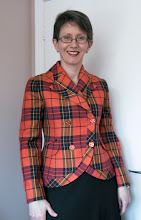In between working on THE DRESS, I've also been making the dress I will wear to the wedding. It's my version of an OOP Vogue pattern designed by the late Patricia Jeanne Keay.
I instantly thought that the pictured celadon green linen dress was just about the most beautiful creation I had ever seen. Those embellishments! So unique.
Anyhow I didn't forget about the dress and when I saw this Vogue pattern published seven years later, I bought it instantly. But it has been languishing in my collection unused since then, waiting for a suitable occasion.
I decided that my son's wedding would qualify, so I got it out and did a muslin. The pattern has lining pieces that end in a level hem (at a high mini-skirt level) and I used them to check the fit.
I found that the pattern, unlike the red version on the pattern envelope, but very much like the green version in the article, had an extremely wide and open neckline, with the shoulder "straps" set so wide that they would be of no use in actually holding the dress on the wearer's body. It was far too wide and open to fit me properly, or to be comfortable.
I was able to adjust the front and back neck by different amounts to fix this problem. I took the back in more because it was generally too wide to fit me properly. The front only needed the neckline adjusted.Here's a snap of the adjusted pattern pieces.
You can see the deeper "dart" reducing the overall width of the upper back piece on the left.
Looking at the photo of the back, I could have narrowed the back bodice a bit more, but it is OK.
This adjustment slightly changed the angle where the shoulder "straps" would attach. I had to further adjust this a tiny bit in the back.
I'm calling them "straps" because they are way more interesting than the usual 2 dimensional strap found in a pattern.
The bias piece (see photo at left) is sewn into a tube and then pleats are formed at different angles in the front and back. The result is a nicely 3D piece that cups the top of the shoulder.With my adjustments to narrow the neckline, the dress will be securely bra friendly. Win!
I had lengthened the flounce slightly (about 2.5 cm) and cut the flounce lining a tiny bit shorter. Then I seamed the flounce lining to the flounce at the hem, and attached the upper edge at the dress/flounce seam by hand. This makes for a very smooth and completely invisible hem.
Finally, you ask, what about the bodice embellishment? Isn't this the most important and interesting part of the entire garment?
Why yes of course it is! The Threads article focuses on how to make the skinny bias tendrils and make them curl, and to sew the 3D leaves/petals. I was interested to see that the pattern has a good amount of detail on this too, and in fact the pattern pieces for the leaves were slightly simplified.
Kay's secret to sewing the tubes and turning them right side out is:
(1) To ensure the correct tube dimension, don't focus on the seam allowance width while sewing. Pay attention instead to the width of the tube itself. Simple but critical.
(2) After sewing the seam use your serger to beef up the seam allowance with a narrow 3 thread stitch.(3) Fasten the end of a good length of very strong thread to the seam allowance at one end of the tube piece with a secure knot.
(4) Thread a darning needle with the other end of the thread and draw it through the tube.
(5) Pull on the thread while helping the end of the tube where the knot is tied to fold inside. Keep pulling gently until the knotted end appears at the other end of the tube.
No further corsage needed!

.png)













